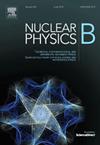Analyzing WGC and WCCC through charged scalar fields fluxes with charged AdS black holes surrounded by perfect fluid dark matter in the CFT thermodynamics
IF 2.5
3区 物理与天体物理
Q2 PHYSICS, PARTICLES & FIELDS
引用次数: 0
Abstract
In this paper, we conduct a comprehensive investigation into the weak cosmic censorship conjecture (WCCC) for Reissner-Nordström (R-N) AdS black holes that are influenced by Perfect Fluid Dark Matter (PFDM). Our study is framed within the context of Conformal Field Theory (CFT) thermodynamics. We delve into the principles of energy flux and mass-energy equivalence to explore the interplay between the weak gravity conjecture (WGC) and the WCCC. Our analysis begins by examining the interaction between incoming and outgoing energy fluxes, which induces changes in the black hole's properties. By applying the first law of thermodynamics, we assess the validity of the second law in these dynamic scenarios. We also consider equilibrium conditions that involve both absorption and superradiance processes. Utilizing the framework of black hole thermodynamics within CFT, we demonstrate that the WCCC is upheld if the black hole is in or near an extremal state, particularly when it is subjected to radiation and particle absorption. This finding is significant as it reinforces the robustness of the WCCC under these specific conditions. Furthermore, we uncover additional insights by employing mass-energy equivalence principles and conducting second-order approximations near the extremality state. Specifically, we find that when a black hole radiates and its central charge surpasses the scaled electric charge, the emitted superradiant particles adhere to the WGC. This adherence results in the black hole moving away from its extremal state, thereby maintaining the WCCC.
通过CFT热力学中被完美流体暗物质包围的带电AdS黑洞的带电标量场通量分析WGC和WCCC
本文章由计算机程序翻译,如有差异,请以英文原文为准。
求助全文
约1分钟内获得全文
求助全文
来源期刊

Nuclear Physics B
物理-物理:粒子与场物理
CiteScore
5.50
自引率
7.10%
发文量
302
审稿时长
1 months
期刊介绍:
Nuclear Physics B focuses on the domain of high energy physics, quantum field theory, statistical systems, and mathematical physics, and includes four main sections: high energy physics - phenomenology, high energy physics - theory, high energy physics - experiment, and quantum field theory, statistical systems, and mathematical physics. The emphasis is on original research papers (Frontiers Articles or Full Length Articles), but Review Articles are also welcome.
 求助内容:
求助内容: 应助结果提醒方式:
应助结果提醒方式:


